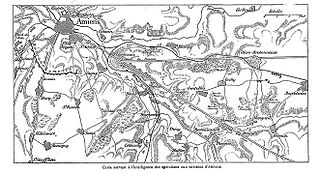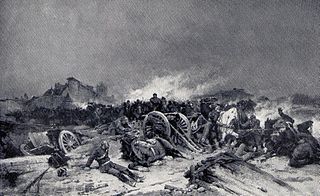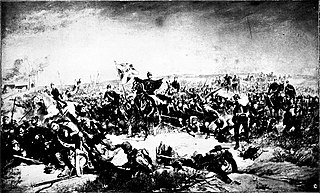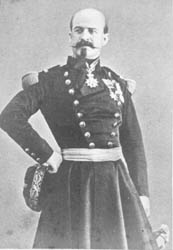 W
WA constitutional referendum was held in France on 8 May 1870. Voters were asked whether they approved of the liberal reforms made to the constitution since 1860 and passed by the Sénatus-consulte on 20 April 1870. The changes were approved by 82.7% of voters with an 81.3% turnout. However, France's defeat in the Franco-Prussian War caused the Empire to be abolished later that year. Despite this being the ninth constitutional referendum in French history, it was the first to have more than 8% oppose the motion, and one of only four to that point to have less than 99% official approval.
 W
WThe Battle of Amiens, also known as the Battle of Villers-Bretonneux, was fought on 27 November 1870 between French and Prussian forces during the Franco-Prussian War (1870–1871). It ended in a Prussian victory, forcing the French to retreat and allowing the Prussians to capture Amiens, France.
 W
WThe Battle of Beaune-la-Rolande on 28 November 1870 was a battle of the Franco-Prussian War, won by Prussia. In an attempt to relieve the Siege of Paris, French General Crouzat's XX Corps launched an attack against three Prussian brigades resting in Beaune-la-Rolande. These brigades were from the Prussian X Corps which was detailed to guard the flanks and rear of the force besieging Paris and provide early warning of any French counter-attacks. The French committed a force of 60,000 men, largely conscripts of the Garde Mobile, and 140 guns against the Prussians' 9,000 men and 70 guns, mostly drawn from regular troops. Despite the overwhelming superiority of numbers the French attack failed to take the village and was ultimately forced to retreat by Prussian reinforcements.
 W
WThe Battle of Borny–Colombey or the Battle of Colombey-Nouilly took place on 14 August 1870 as part of the Franco–Prussian War. During the battle the escape route of the French army under François Bazaine was blocked when the French encountered the First Army under von Steinmetz. The outcome of the battle itself was indecisive although the French were able to escape to Metz.
 W
WThe Battle of Coulmiers was fought on 9 November 1870 between French and Bavarian forces during the Franco-Prussian War, ending in French victory.
 W
WThe Battle of Gravelotte on 18 August 1870 was the largest battle of the Franco-Prussian War. Named after Gravelotte, a village in Lorraine, it was fought about 6 miles (9.7 km) west of Metz, where on the previous day, having intercepted the French army's retreat to the west at the Battle of Mars-La-Tour, the Prussians were now closing in to complete the destruction of the French forces.
 W
WThe Battle of Hallue was a battle of the Franco-Prussian War on December 23 and 24, 1870.
 W
WThe Battle of Loigny–Lumeau-Poupry was a battle of the Franco–Prussian War. It took place on 2 December 1870 during the Loire Campaign on a frontline between Loigny, Lumeau and Poupry.
 W
WThe Battle of Mars-La-Tour was fought on 16 August 1870, during the Franco-Prussian War, near the village of Mars-La-Tour in northeast France. One Prussian corps, reinforced by two more later in the day, encountered the entire French Army of the Rhine in a meeting engagement and, surprisingly, forced the Army of the Rhine to retreat toward the fortress of Metz.
 W
WThe Battle of Noisseville on 31 August 1870 was fought during the Franco-Prussian War and ended in a Prussian victory.
 W
WThe Battle of Sedan was fought during the Franco-Prussian War from 1 to 2 September 1870. Resulting in the capture of Emperor Napoleon III and large numbers of his troops, it effectively decided the war in favour of Prussia and its allies, though fighting continued under a new French government.
 W
WThe Battle of Spicheren, also known as the Battle of Forbach, was a battle during the Franco-Prussian War. The German victory compelled the French to withdraw to the defenses of Metz. The Battle of Spicheren, on 6 August, was the second of three critical French defeats. Moltke had originally planned to keep Bazaine's army on the Saar river until he could attack it with the 2nd Army in front and the 1st Army on its left flank, while the 3rd Army closed towards the rear. The aging General von Steinmetz made an overzealous, unplanned move, leading the 1st Army south from his position on the Moselle. He moved straight toward the town of Spicheren, cutting off Prince Frederick Charles from his forward cavalry units in the process.
 W
WThe Battle of Villepion was a battle between the French XVI Corps under General Chanzy and the I Bavarian Corps during the Franco-Prussian War. It occurred in the district of Terminiers, between Terminiers and Nonneville on 1 December 1870, and ended in a French victory.
 W
WThe Battle of Villiers, also called the Battle of Champigny, was the largest of the French sorties from besieged Paris during the Franco–Prussian War.
 W
WThe Battle of Wissembourg or Battle of Weissenburg, the first of the Franco-Prussian War, was joined when three German army corps surprised the small French garrison at Wissembourg on 4 August 1870. The defenders, greatly outnumbered, fought stubbornly... especially considering they were surprised and greatly outnumbered, that the French sustained their old renown as fighting men and that the first defeat, although severe, reflected no discredit on the soldiers of the 1st Corps."
 W
WThe Battle of Wörth, also known as the Battle of Reichshoffen or as the Battle of Frœschwiller, refers to the second battle of Wörth, which took place on 6 August 1870 in the opening stages of the Franco-Prussian War. In the second battle, troops from Germany commanded by Crown Prince Frederick and directed by his Chief of Staff, General Leonhard Graf von Blumenthal, defeated the French under Marshal MacMahon near the village of Wœrth in Alsace, on the Sauer River, 10 kilometres (6.2 mi) north of Haguenau.
 W
WThe Battle of Bazeilles was fought on 1 September 1870 during the Franco-Prussian War as a portion of the larger Battle of Sedan and was one of the first battles to feature modern urban warfare tactics. It took place in Bazeilles, France, a small village in the department of Ardennes near Sedan, and involved a force of Bavarian soldiers battling against French marines and partisans.
 W
WThe Battle of Beaumont on 30 August 1870 was won by Prussia during the Franco-Prussian War.
 W
WThe Battle of Bellevue on 7 October 1870 was fought during the Franco-Prussian War and ended in a Prussian victory.
 W
WThe (First) Battle of Buzenval, part of the siege of Paris during the Franco-Prussian War. The besieged troops in Paris, under the orders of General Louis Trochu, made a sortie in the direction of Versailles.
 W
WThe Émile Ollivier ministry was the penultimate government of the Second French Empire. Led by Émile Ollivier, a republican opponent of the Empire, it was initially composed of moderate bonapartists and orléanists. However following the constitutional referendum on 8 May liberal members of the cabinet resigned and were replaced with politicians of a more authoritarian type. It lasted from 2 January 1870 until 10 August 1870, on the outbreak of the Franco-Prussian War, when it was replaced by the Cousin-Montauban ministry. It was often referred to at the time as the Ministry of 2 January.
 W
WThe Cousin-Montauban ministry was the last government of the Second French Empire. It lasted from 10 August-4 September 1870. It was formed by Empress Eugenie in an attempt to rally France's defendes against the invading Prussians. The ministry was forced out of power following the French defeat at the Battle of Sedan.
 W
WThe Ems Dispatch, sometimes called the Ems Telegram, was published on 13 July 1870 and incited the Second French Empire to start the Franco-Prussian War and to declare war on the Kingdom of Prussia on 19 July 1870. The actual dispatch was an internal message from Prussian King Wilhelm I's vacationing site to Otto von Bismarck in Berlin, reporting demands made by the French ambassador. Bismarck, the chancellor of the North German Confederation, released a statement to the press that stirred up emotions in France and Germany.
 W
WThe Franco-Prussian War or Franco-German War, often referred to in France as the War of 1870, was a conflict between the Second French Empire and the German states of the North German Confederation led by the Kingdom of Prussia. Lasting from 19 July 1870 to 28 January 1871, the conflict was caused primarily by France's determination to restore its dominant position in continental Europe, which it had lost following Prussia's crushing victory over Austria in 1866. According to some historians, Prussian chancellor Otto von Bismarck deliberately provoked the French into declaring war on Prussia in order to draw four independent southern German states—Baden, Württemberg, Bavaria and Hesse-Darmstadt—into an alliance with the North German Confederation dominated by Prussia. Some historians contend that Bismarck exploited the circumstances as they unfolded. None, however, dispute the fact that Bismarck must have recognized the potential for new German alliances, given the situation as a whole.
 W
WThe Government of National Defense was the first government of the Third Republic of France from 4 September 1870 to 13 February 1871 during the Franco-Prussian War. It was formed after the Emperor Napoleon III was captured by the Prussian Army. The government, headed by General Louis Jules Trochu, was under Prussian siege in Paris. Breakouts were attempted twice, but met with disaster and rising dissatisfaction of the public. In late January the government, having further enraged the population of Paris by crushing a revolutionary uprising, surrendered to the Prussians. Two weeks later, it was replaced by the new government of Adolphe Thiers, which soon passed a variety of financial laws in an attempt to pay reparations and thus oblige the Prussians to leave France, leading to the outbreak of revolutions in French cities, and the ultimate creation of the Paris Commune.
 W
WThe Siege of Metz lasting from 19 August – 27 October 1870 was fought during the Franco-Prussian War and ended in a decisive Allied German victory.
 W
WThe Second Battle of Orléans was a battle of the Franco-Prussian War of 1870. It took place on December 3 and 4, 1870 and was part of the Loire Campaign. The Germans recaptured Orléans, which had been retaken by the French on November 11, 1870 after the Battle of Coulmiers, and divided the French Army of the Loire in two. The French lost 19,000 men in two days of combat, including 12,000 prisoners as well as 74 guns and four gunboats. German manpower losses amounted to 1,746, of which 353 killed or dead of wounds, 1,327 wounded and 67 missing. The Germans lost 368 horses, including 175 killed, 183 wounded and 10 missing.
 W
WThe Siege of Belfort was a 103-day military assault and blockade of the city of Belfort, France by Prussian forces during the Franco-Prussian War. The French garrison held out until the January 1871 armistice between France and the German Empire obligated French forces to abandon the stronghold in February 1871.
 W
WThe siege of Paris – that took place from 19 September 1870 to 28 January 1871 and the consequent capture of the city by Prussian force – culminated in France's defeat in the Franco-Prussian War and the establishment of both the German Empire and Paris Commune.
 W
WThe Siege of Strasbourg took place during the Franco-Prussian War, and resulted in the French surrender of the fortress on 28 September 1870.
 W
WThe Siege of Toul was the siege of the fortified French town of Toul from 16 August to 23 September 1870 by Prussian, Bavarian and Württemberg forces during the Franco-Prussian War. Toul controlled a railway line leading to Germany and it was vital for the Germans to secure it to resupply and reinforce their armies in northern France.